Jump to:
How much does a perm cost? And how do perms work? Can I do it at home? If you’re asking any of these questions, you NEED to read the guide below. We’ll answer these and much more below.
How Much Does a Perm Cost?
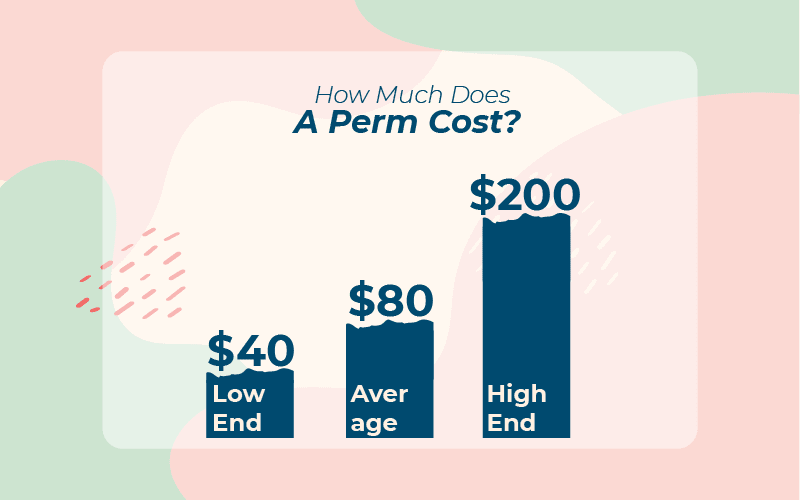
If you’re thinking about going curly, you’re probably wondering, “How much does a perm cost?” There are many different types of perms, and the cost varies. However, here’s the simple answer:
Getting a perm costs anywhere from $40 to $200 on average, but most people will pay around $80.
It’s a wide price range because there are so many different options and factors. The overall cost depends on your hair’s length, the type of perm you get, and whether you opt for a partial or full perm.
It’s cheaper to get a partial perm than a full perm, and shorter hair costs less to perm than long hair. Perms may make you think of the ’80s and ’90s, but today, they’re back with a vengeance.
Modern perms offer a range of curls, waves, and coils to fit your style. You can wake up every morning with a soft, beachy wave that is worlds away from the ultra-curly perm you had in 7th grade.
Or, if tight curls that bounce are more your style, a spiral perm is precisely what you’re looking for. Since there are so many different types of perms, you’ll want to learn about each one and how much they cost before heading to the salon.
You can go for anything from soft waves to tiny ringlets. As long as you know what to ask your stylist for, you can opt for any type of curl you prefer.
Keep reading to learn about how perms work, the different types of perms you can get, and how much they cost.
How Do Perms Work?
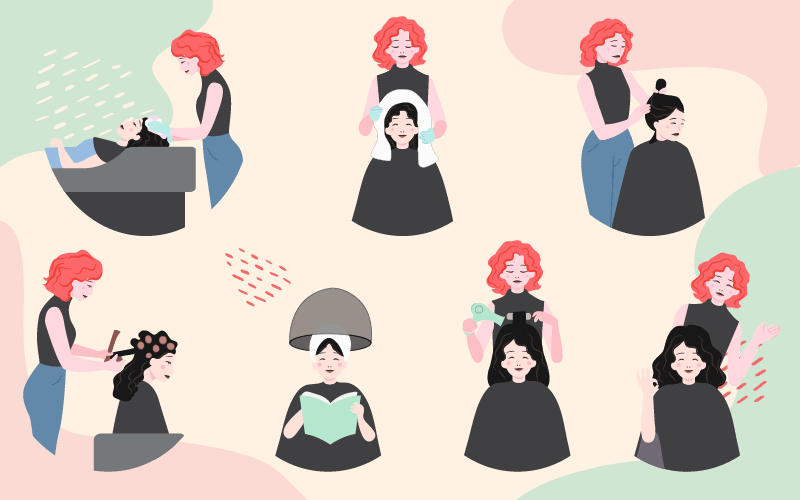
Perms actually alter the texture of your hair using chemicals. The perm solution makes the hair stay in the curvature of the perm rods used to “train” the hair while the chemicals are applied.
It does this by using alkaline or acidic chemical to break the disulfide bonds in the hair. This makes it malleable and easy to retrain in a new curvature. If acidic chemicals are used in the perm solution, heat is sometimes applied to activate it.
After the perm solution is allowed to sit on the hair and penetrate it, it’s followed by a neutralizer that stops the chemical processing and restores the disulfide bonds in the hair through oxidation.
The size of the perm rod used and the strength of the perm solution (or waving lotion) used affects the final results. Smaller rods make tighter curls; larger rods result in gentle waves or additional body in the hair.
Perm Cost by Type
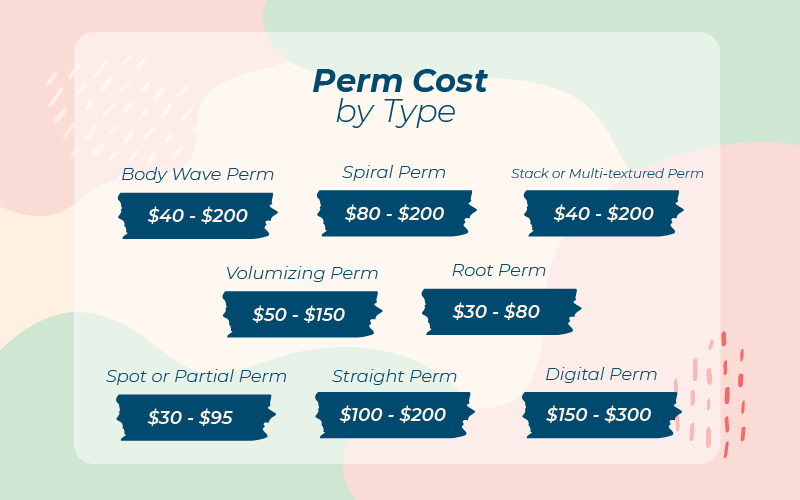
How much does a perm cost? That depends on a few factors, but here’s a look at the average cost of different types of perms. Keep in mind that the lower end reflects pricing for short hair (or partial perms), and the high end reflects pricing for long hair.
- Body wave perm: $40-$200
- Spiral perm: $80-$200
- Stack or multi-textured perm: $40-$150
- Volumizing perm: $50-$150
- Root perm: $30-$80
- Spot or partial perm: $30-$95
- Straight perm: $100-$200
- Digital perm: $150-$300
Perm Cost by Hair Length

How much does a perm cost for short, medium, and long hair? The costs are actually quite different. Find out how much you will pay for a perm depending on the length of your hair below.
- Short hair perm: $30-$100
- Medium hair perm: $60-$200
- Long hair perm: $80-$200
As you can see, short hair is cheaper to perm than medium or long hair. The longer the hair, the longer it takes to roll the hair on perm rods, the more perm lotion and neutralizer will be used.
Since the stylist will use more supplies and spend more time finishing the service, the price is higher (though that’s just common sense).
Types of Perms
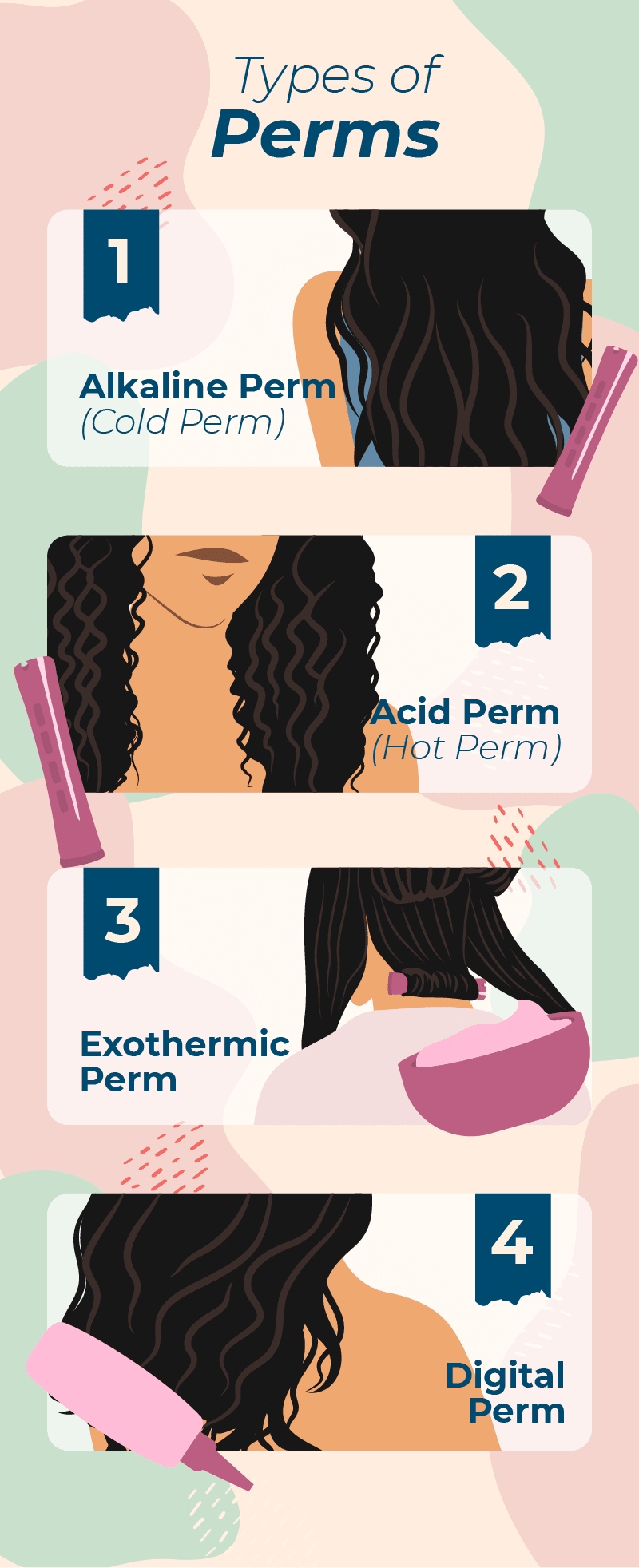
When we talk about different types of perms, there are generally two ways to describe them. The first is the type of chemical solution and heat method used to permanently wave or curl the hair.
That’s what we’ll cover in this section. Next, we’ll take a look at the different types of curl styles you can get from perms.
1. Alkaline Perm or Cold Perm
Alkaline, ceramic, or cold perms use a perm lotion or solution with a pH from 8.2 to 9.6. They’re called cold perms because no heat is required to create the curls.
The alkaline chemical in cold perms is ammonium thioglycolate, and it’s powerful. Spiral curls from cold perms generally last longer and have more volume than curls from hot perms.
2. Acid Perm or Hot Perm
Acid perms don’t use an alkaline chemical, but an acidic chemical called glyceryl monothioglycolate instead. The pH of an acid perm solution or lotion ranges between 4.5 to 7.
Heat is required to set the curls (that’s why they’re sometimes called hot perms).
It’s gentler on the hair than a cold perm, so it’s suitable for people with damaged hair. There are more possibilities for the types of curls you can get from hot perms.
3. Exothermic Perm
Exothermic perms can be acidic or alkaline. What makes them unique is that the perm solution itself will create chemical heat when the solution is mixed. That chemical heat opens the hair shaft up and creates the curls once the hair is wrapped around perm rods.
4. Digital Perm
Digital perms are one of the newest trends in perms. They are a type of hot perm. After the acidic perm solution is applied, the hair is wrapped around perm rods that are digitally temperature controlled. These digital perm rods are expensive, so expect a digital perm to cost more than other types.
Types of Perm Curls

Now we’ll look at the types of curls you can get from a perm. There are many options to choose from, so make sure you know which type of curl or wave you want before heading to the salon. You can even get a straight perm if you want to ditch the flat iron.
1. Body Wave Perm
Body wave perms create soft, voluminous waves instead of tight curls. If your hair lacks volume or is pin-straight, you might consider a body wave perm.
For the best results, a stylist will use an acid or hot perm solution along with large perm rods to give you a body wave perm. The rods will be placed in a natural pattern instead of perfect rows to give your hair a relaxed look.
2. Spiral Perm
Spiral perms give your hair bouncy curls similar to those you’d get from a curling iron. These perms are done with an alkaline or cold perm solution.
The size of the perm rod used will dictate the size of the finished curls. Smaller rods will produce tighter spiral curls, while larger rods will give you softer spiral curls.
The stylist will place the rods in a uniform pattern all over your head to keep the curls looking neat. Since these perms create strong curls, it’s recommended for hair that is at least to your shoulders.
3. Stack or Multi-Textured Perm
A stack perm or multi-textured perm makes use of a few different sizes of perm rods to give you natural-looking, textured curls that range in size.
The hair may be permed tighter in some sections and looser in others to make it appear that the hair is layered.
4. Volumizing Perm
A volumizing perm gives hair added volume and body without tight curls. It can be done with any type of perm solution.
The difference is all in the way it’s taken down and neutralized. When you get a volumizing perm, the perm rods are taken out before the neutralizer is added.
This results in slight waves and more volume without the tight curls you might get if you applied the neutralizer before taking the rods out.
5. Root Perm
Root perms are used to inject extra volume right at the root of the hair. Instead of rolling and perming all the hair on the head, only the 2-4″ closest to the scalp are permed.
The larger perm rods used this close to the scalp lifts the hair at the root. Since the rods have to be so close to the scalp, root perms are always cold perms (alkaline solution).
With fewer rods being used and less perm solution and neutralizer needed, these perms are less expensive than other types.
6. Spot or Partial Perm
Spot or partial perms target specific sections of the hair instead of the entire head. You might get a spot perm if you have curly hair that is flatter in some areas.
Spot perms are also popular for anyone with thinning sections of hair that need some additional oomph. You can even get a spot or partial perm for just the ends of your hair.
This is great for anyone who likes the texture of their hair but wants a little more movement at the ends. It creates a true wash-and-go style. Spot or partial perms can be done with a hot or cold perm solution.
7. Straight Perm
It might sound a little backward since most of us associate perms with curls, but you can also get a straight perm. You might hear this type of perm called a Japanese straight perm or a reverse perm.
Whether you have curly or wavy hair or just want additional smoothness, this hot-perm technique can straighten your locks.
First, a chemical solution is applied to the hair and allowed to penetrate the cuticle to break the cysteine bonds (responsible for making curls). Then, you’ll sit under a dryer to heat the hair.
The hair will be straightened with a flat iron, then doused with a neutralizer to restore the bonds in the hair. When the hair is dried, it will remain straight until it grows out.
Things to Consider Before Getting a Perm
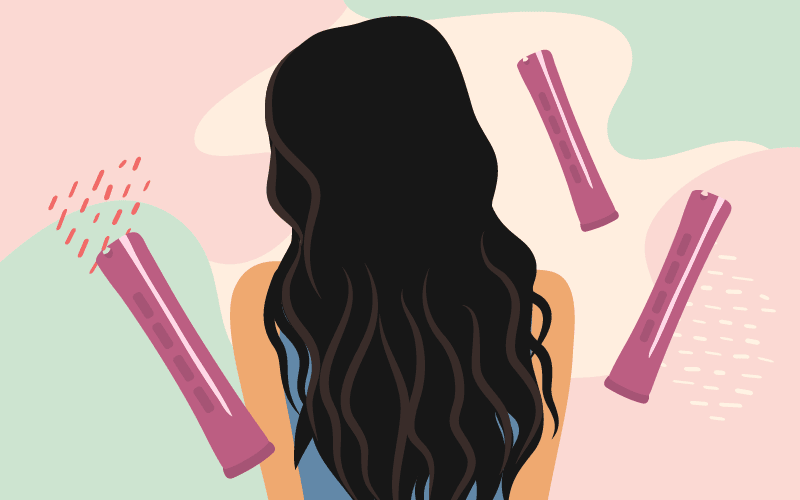
Here are a few things you should keep in mind before you get a perm (and afterward). Ensuring you know what to expect will make the process go smoothly and ensure you get the best possible results from your perm.
- You can’t wash your hair for up to 48 hours afterward. Once you get a perm, you’ll need to hold off on washing it or getting it wet for about 24-48 hours. Washing too soon will loosen the curls or cause them to fall out.
- It will last 2-6 months. Your hair’s health and texture have a lot to do with how long the perm will last, but in general, expect 2-6 months of curls before they begin loosening up or fading away.
- Perms dry your hair out. After getting a perm, you’ll have to be purposeful about moisturizing and conditioning your locks. At first, it’s recommended to use a deep conditioning treatment twice a week. Scale back to once a week after the first month.
- Not all perms are “wash-and-go.” If you’re hoping to get a perm so you won’t have to style your hair, you may be disappointed with certain types of perms. Spiral perms, root perms, and multi-textured perms will all require some styling to look their best.
- Alkaline or cold perms really stink. They may give great results, but alkaline-based perm solutions really smell bad. The smell has been compared to rotten eggs or a skunk. This odor comes from the ammonia in the solution, so either prepare for the stink or opt for a hot (acidic) perm instead.
- Go easy on colors and highlights after a perm. Perms change the chemical structure of your hair and can be damaging. So you’ll want to hold off on doing any other chemical processes on your hair for a few months afterward.
- Ask your stylist for curl recommendations first. Even if you know the type of curls you want from a perm, ask your stylist for an opinion on which type would suit you best. They might recommend something you hadn’t considered yet.
- Don’t get a perm until you’re sure. Perms can last six months or even longer, and that’s a long time to be stuck with a style you hate. Make sure you’re committed to long-term curls before getting a perm.
Now that you know how much a perm costs, you’re armed with the knowledge you need to hit the salon.
